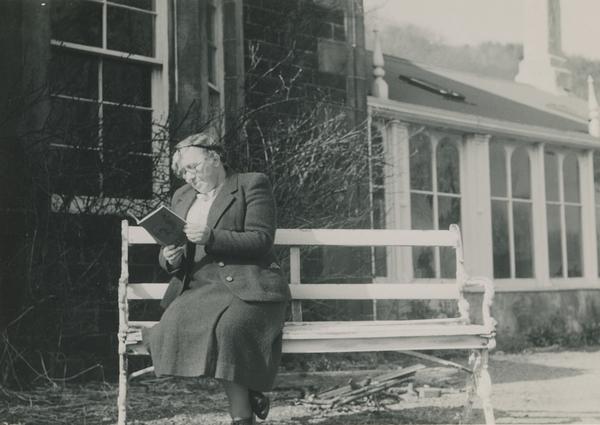Biography
Annie Johnston (Annag Aonghais Chaluim Bhàin 'ic Dhòmhnaill 'ic Chaluim) was a Gaelic tradition-bearer, folklore collector, activist, and teacher from the Isle of Barra. Born in the late 1880s, she was raised in a community which was rich in Gaelic language and culture, but one which was also still coming to terms with the decades of displacement, famine and institutional neglect which had blighted the island for the larger part of the 19th century.
Annie was one of eight children born to Catherine MacNeil (Catrìona Aonghais 'ic Dhòmhnaill Mhòir) and Angus Johnston (Aonghas Chaluim Bhàin). Her mother was originally from the now uninhabited Isle of Sandray, and it was from her that Annie learned many of her songs and stories. She was especially known for her vast knowledge of òrain bheaga – short songs which were especially popular with children, and òran luaidh – waulking songs, many of which were recorded, and which now feature on the Tobar an Dualchais website.
Although a tradition-bearer in her own right, Annie was known throughout her life for her ability to encourage and empower others to share their rich stores of song and story. A schoolteacher of young children by profession, she used her status in the community and her nurturing nature to encourage neighbours, friends, and family to be recorded by folklorists and collectors who visited Barra. When Marjory Kennedy-Fraser visited in the 1920s, Annie would invite groups of older women to her parents' home, where she would encourage them to sing while Kennedy-Fraser recorded them.
John Lorne Campbell's arrival in Barra in the 1930s would mark the beginning of a long and fruitful collaboration and friendship between Annie and John. Similar to the help she offered Kennedy-Fraser, Annie would use her privileged position in the community – independently and as part of the Barra Folklore Committee – to reach out and encourage people to be recorded by Campbell. She also worked with Campbell and supplied him with local information for publications, which included his edition of Father Allan MacDonald's 'Gaelic Words from South Uist' (1958), as well as 'Deoch-slàinte nan Gillean' (1948), 'Gaelic Folksongs from the Isle of Barra' (1950) and 'Stories from South Uist' (1961). She often visited John Lorne Campbell and Margaret Fay Shaw in Canna, following their purchase of and relocation to the island in the late 1930s.
Following the establishment of the BBC and of Gaelic broadcasting, Annie took full advantage of the new technology and contributed greatly through the broadcasting of songs for Gaelic radio programmes, contributing over forty songs between 1947 and 1962. She also featured in broadcasts of the Royal National Mòd, and two such recordings can be found on the Tobar and Dualchais website: Coisich a Rùin and Tha an Oidhche a-nochd Fuar.
The legacy and reach of Annie's dedication and encouragement of Gaelic culture did not stop at Castlebay Pier. From the 1920s until her death she nurtured a strong connection with the Gaels of Nova Scotia, keeping in touch with many of them by letter and also through contributions to Nova Scotia publications such as 'Mosgladh' – the Scottish Catholic Society Magazine, and to Achadh nan Gàidheal – the weekly Gaelic column in the Antigonish newspaper 'The Casket', which was edited by Msgr P J Nicholson – a Professor of Physics at Saint Francis Xavier University from Cape Breton.
In 1954, Annie journeyed across the Atlantic, visiting Nova Scotia and Boston, visiting fellow Gaels and often also collecting folklore from them. The transatlantic trip had a profound effect on Annie, and in a letter to Msgr Nicholson, she stated that she enjoyed it more than anything else in her lifetime. She made reference to the kindness and generosity of the people, especially in the Grand Narrows of Cape Breton, where she stated that she was so happy she wondered if she might have been in the 'Sìthean' – the Fairy Mound.
Annie was also recorded extensively in her own right, and there are over 160 recordings of her on the Tobar an Dualchais website spanning from 1938 until 1962 from all three of our partner archives. Amongst the earliest of these recordings is a rendition of the children's song Tobar, Tobar, Sìolaidh from the Canna Collection – a song that would be sung by children at the well when fetching water. Other notable recordings include Cainnt nan Eun – a compilation of rhymes imitating native birds, and Brà Brà Bleith – a rendition of a quern song, recorded in 1951. She is also listed as a fieldworker on a number of recordings, most notably for those of Mrs Mary Johnston (Màiri Mhòr Iain Choinnich) of Glen, Barra.
Annie's brother, Calum Johnston, was also a renowned tradition bearer, known especially for his piping and his òrain mhòra – the great Gaelic songs.
